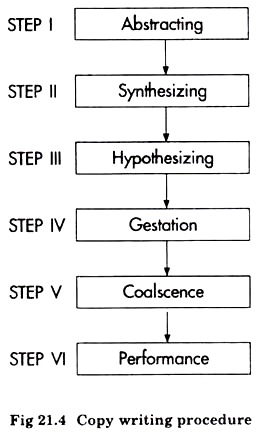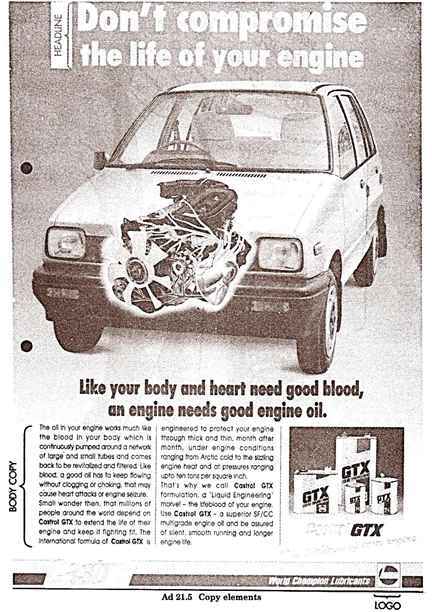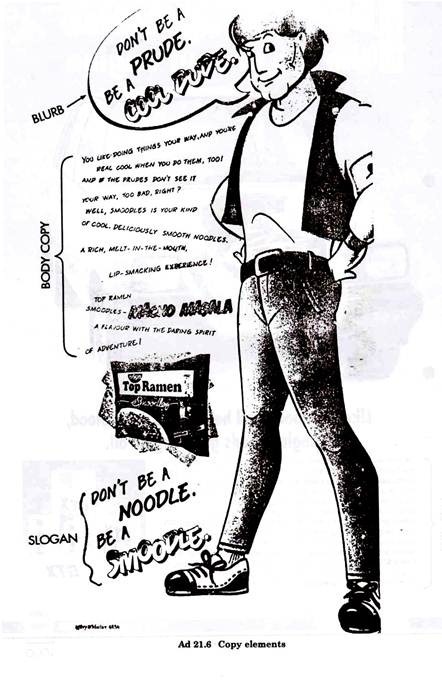After reading this article you will learn about copy writing as a form of communication.
Copy Writing:
Copy writing is a specialized form of communicating ideas that are meant to serve the requirement of modern marketing. The purpose is to inform or persuade or remind or collective. But before copy writing the objective of the copy should be well defined.
The copy writer must be totally familiar with the marketing goals of the advertiser and specific advertising objective. Copy writing skill require command over language and on intellectual and creative mentality.
ADVERTISEMENTS:
Steps in Copy Writing:
Creativity is of paramount importance initiating the process of writing a copy. Creative ardour has to be combined with purposeful thinking.
According to Clarke, there are following steps (Fig. 21.4) in copy writing:
Step-I:
ADVERTISEMENTS:
Abstracting:
Relevant data are obtained from the market situation, prospects and relevant media.
Step-II:
ADVERTISEMENTS:
Synthesizing:
Elements are blended and combined, ideas and approaches accepted, rejected, revised etc.
Step-III:
Hypothesizing:
ADVERTISEMENTS:
Ideas formulated into experimental patterns culminating in a working statement.
Step-IV:
Gestation:
Objection and difficulties resolved may involve discussion with others or reference to sources of information.
ADVERTISEMENTS:
Step-V:
Coalescence:
Decisions are made for transference of ideation to physical expression; i.e. writing.
Step-VI:
ADVERTISEMENTS:
Performance:
Action is taken in the form of actual writing.
Copy Structure:
The total advertising copy can be classified into:
ADVERTISEMENTS:
(a) Head line
(b) Body copy
(c) Close of the copy.
(a) Head Line:
The head line is that part of the copy which has been made to stand out in the advertisement by the size or style of type in which it has been set. The function of a head line is to attract the favourable attention of prospective purchasers and to interest them so that they will read the advertisement.
The head line style and content will vary according to the product and the purpose may be presented in the following way:
ADVERTISEMENTS:
1. An indirect head line that arouse the curiosity of the reader.
2. State benefit to the customer.
3. A questioning approach.
4. News oriented head line.
5. Address to buyer directly.
(b) Body Copy:
ADVERTISEMENTS:
Body copy is the middle part of the advertisement which includes the text of the advertisement.
A copy should do the following things in order to produce results:
1. Involve the reader.
2. Help the reader.
3. Conviction.
4. Inducing a response.
ADVERTISEMENTS:
5. Inform.
6. Persuade.
7. Create interest.
(c) Close of the Copy:
Close of the copy calls for action. A copy may be concluded by a specific selling approach i.e. hard sell or soft sell. Hard sell calls for instant action like ‘one day sale’, ‘limited quantity’, ‘offer valid till stock lasts ‘, ‘first come first serve’. In hard sell copy is pushy. Soft sell calls for persuation in the phased manner but does not call for instant purchase.
Copy Elements:
(a) Headline
ADVERTISEMENTS:
(b) The Sub head
(c) The Body Copy
(d) Captions
(e) The blurb or baloon
(f) Boxes & Panels
(g) Slogan, logo types & signature
ADVERTISEMENTS:
(a) Head Line:
Presents the selling idea. Primary function is to catch the eye of the reader. Head line need not always contain special message. Company or brand name could be used as a head line.
(b) The Sub Head:
Important facts may be conveyed require more space than the head line. All advertisements do not require sub heads.
(c) The Body Copy:
Refers to the text in the advertisement. Contains details regarding the functions of the product/service and its benefits. Body copy can be short or long.
(d) Captions:
Are small units of type used with illustrations, coupons and special offers. It can be in the form of picture option.
(e) The Blurb or Baloon:
Display arrangement where words appear from the mouth.
(f) Boxes and Panels:
Special display positions to get greater attention.
(g) Slogan, Logotypes & Signatures:
Logotype—company name, seal or trade mark also refer to signature. Logotype is an important aid in quick recognition.
Characteristics of Effective Copy:
A good copy should have the following characteristics:
1. It should be concise.
2. It should have aim to sell.
3. It should be addressed according to the type of audience.
4. It should influence the reader’s thoughts and/or action.
5. It should inspire confidence.
6. It should be precise.
7. It should be sincere.
8. It should create desire.
9. It should stimulate interest.
10. It should aim to sell.


